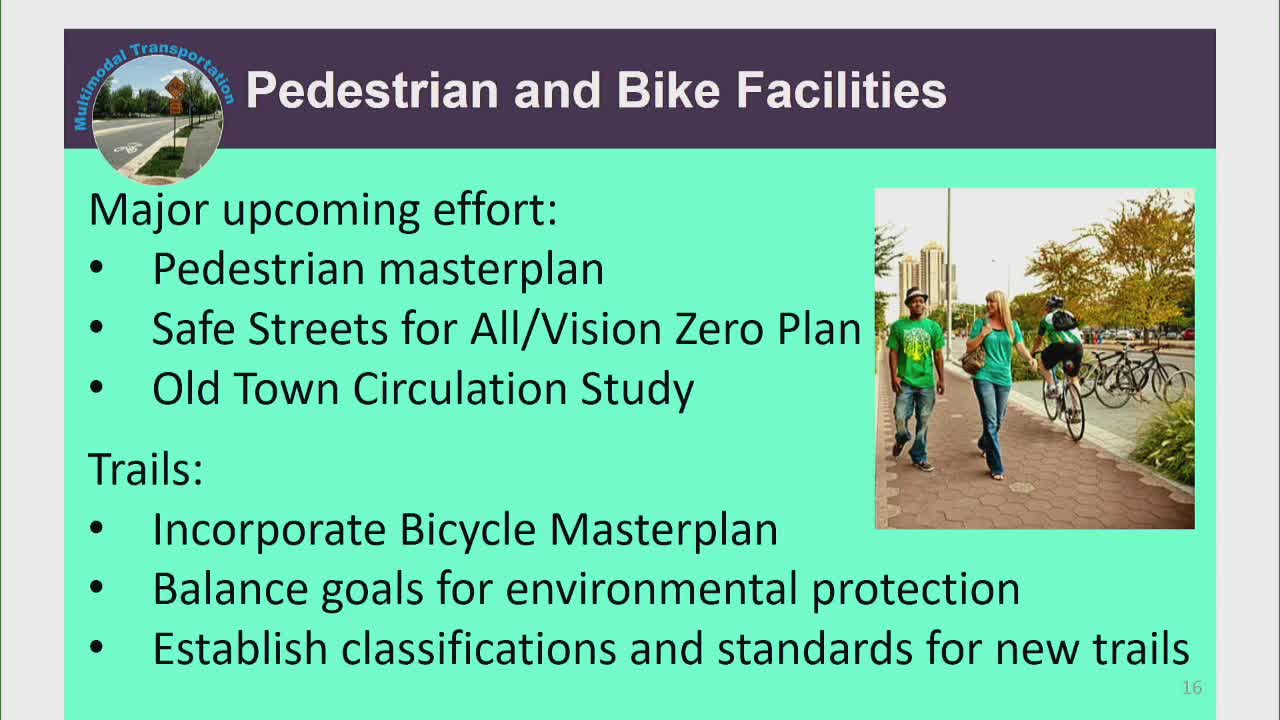City plans bold transportation overhaul to enhance trails and biking
June 11, 2024 | Fairfax City, Fairfax County, Virginia

This article was created by AI summarizing key points discussed. AI makes mistakes, so for full details and context, please refer to the video of the full meeting. Please report any errors so we can fix them. Report an error »

In a recent government meeting, officials discussed proposed amendments to the comprehensive plan, emphasizing the need to balance transportation projects with environmental protection goals. The meeting highlighted the importance of integrating various guiding principles related to transportation, natural environment, economic vitality, and land use into future planning efforts.
One significant proposal involves establishing classifications and standards for new trails, which will not be addressed in the current comprehensive plan review but will be considered in the upcoming Parks and Recreation strategic master plan update. This initiative aims to clarify the types of trails being developed, whether they are off-road, dirt paths, or more structured transportation routes, and how funding sources may influence their design and implementation.
Council member Greenfield raised concerns about the community's understanding of how transportation funds are allocated for trail projects, stressing the need for clear communication regarding the implications of using these funds. The discussion underscored the necessity of defining trail standards to avoid confusion and frustration among residents.
Additionally, the meeting addressed the integration of the primary bicycle master plan map into the comprehensive plan, which will replace the existing trails map. This integration includes identifying long-term improvements along major thoroughfares and spot improvements for crossing enhancements. The council also discussed the need for a strategic approach to implementing neighbor ways throughout the city.
The transportation projects map, required by state code, was presented as a guide for future capital improvement projects. Officials clarified that the projects listed are not new but are drawn from existing plans, with many already underway or completed.
Lastly, the council reaffirmed its commitment to promoting the extension of metro services, amending the action from mere support to a more proactive stance on enhancing accessibility to public transportation. This decision reflects a broader strategy to improve transportation infrastructure and connectivity within the community.
One significant proposal involves establishing classifications and standards for new trails, which will not be addressed in the current comprehensive plan review but will be considered in the upcoming Parks and Recreation strategic master plan update. This initiative aims to clarify the types of trails being developed, whether they are off-road, dirt paths, or more structured transportation routes, and how funding sources may influence their design and implementation.
Council member Greenfield raised concerns about the community's understanding of how transportation funds are allocated for trail projects, stressing the need for clear communication regarding the implications of using these funds. The discussion underscored the necessity of defining trail standards to avoid confusion and frustration among residents.
Additionally, the meeting addressed the integration of the primary bicycle master plan map into the comprehensive plan, which will replace the existing trails map. This integration includes identifying long-term improvements along major thoroughfares and spot improvements for crossing enhancements. The council also discussed the need for a strategic approach to implementing neighbor ways throughout the city.
The transportation projects map, required by state code, was presented as a guide for future capital improvement projects. Officials clarified that the projects listed are not new but are drawn from existing plans, with many already underway or completed.
Lastly, the council reaffirmed its commitment to promoting the extension of metro services, amending the action from mere support to a more proactive stance on enhancing accessibility to public transportation. This decision reflects a broader strategy to improve transportation infrastructure and connectivity within the community.
View full meeting
This article is based on a recent meeting—watch the full video and explore the complete transcript for deeper insights into the discussion.
View full meeting
